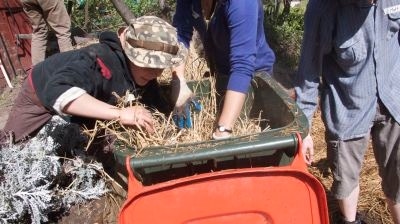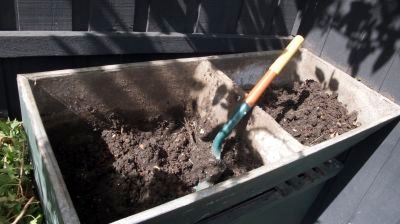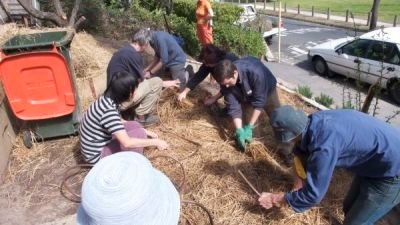Permablitz - Hawthorn
So I went to the permablitz and it was fantastic. There were about 15 people. This is how the day planned out:
- We arrived and had a cuppa together - chatted a bit and got to know each other.
- As a group Adam and Rick took us through the design and we all introduced ourselves.
- Went on our tasks; sorting worm castings, putting up mesh on the bricks, brought in haybales, started to cut timber for the rest of the garden beds, spread worm castings, watered beds, soaked hay to lay.
- Had a quick lesson on pruning trees.
- All got together to learn about the drip irrigation system, we installed the first bed of drip irrigation together. Then the second one.
- Lunch was called - and was an amazing spread!
- We had another little lesson about the earth and the layers of earth and soil in Melbournes west. Where it came from and the characteristics of the land.
- Went for a walk to see how different this street was, as it had different classifications of the soil on the same street.
Major things I learnt that I don’t want to forget:
- The obvious solar orientation of the block is so important. I knew this earlier, but seriously coupled with the choice of plants this can make or break the site/design and the growth of the plants. So plants like grape vines are good in summer cause they provide shading, and in winter they loose their leaves so that they let the light in. This particular site has a west facing front yard and so there were already some stone fruit trees (nectarine and a plum) in the front of the property so that when they grow they will provide shade for the other veggies to grow under.
- Hardy vegetables. During summer this year most of the plants were beaten by the sun. My tomatoes cooked on the bush, not much survived. Items such as capsicums, pumpkin, zucchini, eggplants all grow well in full sun. Any of the leafy veggies, like lettuce and beans, are not great for these locations.
- Chickens. A good idea is to have chicken loose under fruit trees as when the fruit falls the chickens scratch and feed on the fruit and the insects that come to eat the fruit. Then added fertiliser when they poo back on the ground.
- Ground mulch. In this particular garden we were using hay to mulch the areas. There was some talk about the levels of carbon provided in hay and provided in timber wood chips. The fruit trees prefer wood chips because they are high in carbon, where as the vegetables prefer the hay as it is lower in carbon. Tip: if it is very windy, soak the hay in a green wheelie bin before laying it out.

- Worm castings. If you don’t have a tiered worm system and have a home made one, it is easy to separate worms from their castings by getting a large piece of ply and putting the worm castings in the center in a big pile. Separate the pile into smaller piles and remove the castings from the top. Then separate them again, and remove more and more castings while the worms make their way to the bottom away from the light.

- Drip irrigation systems. Usually fed from a mains water system or a water tank it will need a flow meter between the source and the system. The main pipe to get to the garden are as wide as possible to allow the flow of the water to get there (usually 19mm diameter). The drip irrigation pipping is then attached through T-intersections and connections (it is usually 13mm) therefore you will need connections and clamps for the above sized pipes. When placing it out in the garden it is good to have pegs to place it out before you put it under the soil and mulch. It is good to have them at 20-30cm spacings between the drip lines.

In all the day was filled with amazing things to learn, great conversations, good food and I can’t wait till my next one.
If you want to see more photos have a look here.
Comments
mom: Hi Di
This looks just awesome, I would love to join you one day - I have all the info here at home from one of the shows!!! Really good, well done. Mom xx
Marie Antoinette: hi di
i’m glad you were paying attention on the blitz - i’d already forgotten the ins and outs of the irrigation system by the time i got home. i reckon that comes from studying - brain is already overloaded with info.
re. chickens, if you’re going to use them to forage in a domestic orchard, you may need to protect the roots of younger trees as the chickens can damage root systems with their scratching.
michele